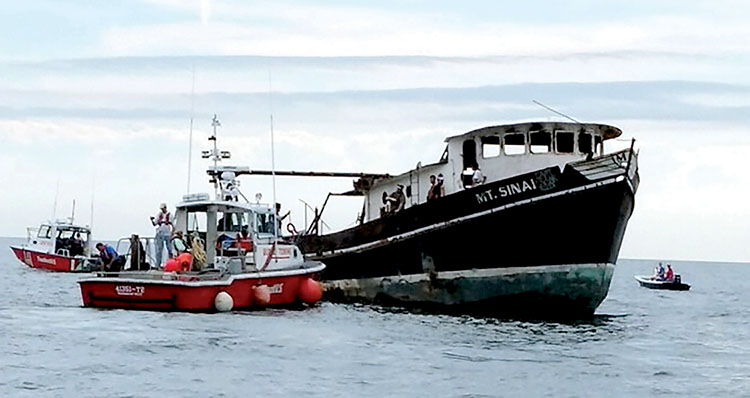By Jay Cook |
POINT PLEASANT BEACH – It’s rare that any news of a boat sinking beneath the depths is celebrated, but an exception occurred last week when the next step was taken for state-protected underwater habitats.
On June 27, the Belford-berthed Mt. Sinai was the first vessel sunk at the Manasquan River Inlet Reef site, supervised by the New Jersey Department of Environmental Protection’s (NJDEP) Division of Fish & Wildlife Artificial Reef Program.
The vessel was an 87-foot trawler, a fishing boat used for dragging along the ocean floor. She was donated to the state by Roy Diehl, a life-long commercial fisherman and president of the Belford Fisherman’s Cooperative, based in the Belford section of Middletown.
“It was a win-win,” Diehl said by phone this week, about the reef project. “The timing was right, they (New Jersey) were looking to do a project, and I was able to get rid of a boat.”
The Manasquan River Inlet Reef was one of two artificial reef sites approved by the U.S. Army Corps of Engineers in April after a longstanding feud between recreational and commercial fisherman over access to the Point Pleasant Reef. The other reef is planned for the Delaware Bay.
“We are very excited to move forward with this expansion of the state’s network of artificial reefs, which create important habitat for many types of marine life,” NJDEP commissioner Bob Martin said in a release at the time.
New Jersey now holds permits for 17 artificial reefs located in New Jersey waters, which cover about 25 miles of ocean floor. New Jersey’s artificial reef network stretches from its northernmost site off Sandy Hook to the southern Cape May location.
The reef sites are commonly anchored with old ships or barges, concrete and steel demolition debris and dredge rock, according to NJDEP. Recreational fishing and scuba diving are popular nautical activities associated with New Jersey reefs.

Although it was the first vessel sunk for the Manasquan River Inlet Reef, the Mt. Sinai was the second overall deployment at the site. The first occurred earlier in June when nearly 1,500 tons of precast concrete, donated by Garden State Precast of Wall, was dropped at the underwater site.
In September, NJDEP anticipates that another vessel will join the Mt. Sinai at the depth of the Manasquan River Inlet Reef site. They plan to sink a 90-foot fire rescue boat around the 16th anniversary of 9/11.
The Mt. Sinai was greeted with sunny skies on its final voyage out to sea last Tuesday. She was sunk in about 75 feet of water at the Manasquan River Inlet Reef, located more than a mile offshore of Point Pleasant.
According to NJDEP, the vessel will have a lifespan on the ocean floor for about 80 years, where more than 150 different species of marine life could soon call the site home.
All towing and preparation expenses for the controlled sinking were paid for by Greater Point Pleasant Charter Boat Association.
The Mt. Sinai had become a landmark of sorts for the fisherman leaving from and returning to the Belford port for fishing trips. It’s jet-black hull, with a bit of rusty-white lettering along the sides, and a rusted-out pulley system, had been tethered in Belford for years.
According to Diehl, the Mt. Sinai was built in 1976 in Bayou La Batre, Alabama. Fans of the novel and subsequent film “Forrest Gump” would know Bayou La Batre as the home of Gump’s wartime friend Bubba, where Gump would eventually buy a boat and successfully jump into the commercial shrimping industry.
She was then shipped to New York where the trawler became part of the fleet for the Mt. Sinai Fishing Company.
Diehl said the boat was purchased by a friend many years back, and was then moved to Belford. That friend fell ill and, for the past five years, Diehl said he had assumed control of the boat.
When Diehl heard about NJDEP looking for vessels for its newly-approved artificial reef, he contacted the state to inform them he might had a vessel for them.
The whole process “was a good deal,” he said. “For the value of the scrap, it was better suited for that purpose.”
This article was first published in the July 6-13, 2017 print edition of The Two River Times.














